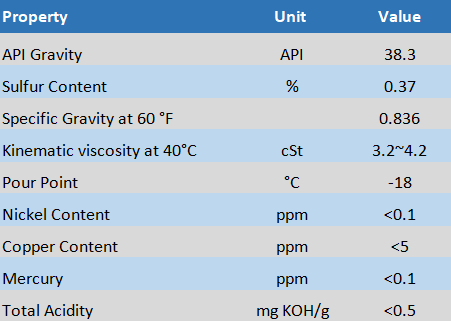Brent crude oil is a benchmark crude oil that is used to price two-thirds of the world’s internationally traded crude oil. Brent crude grade is a light and sweet crude oil that is produced from the Brent oil fields, which are located in the North Sea, off the coast of Scotland and Norway. The Brent crude oil blend is made up of four different crude oils: Brent Blend, Forties Blend, Oseberg and Ekofisk. Brent crude is suitable for the production of gasoline and middle distillates. It is typically refined in Northwest Europe.
Brent crude oil has a low sulfur content, typically around 0.37%, and an API gravity of around 38.06, which makes it a desirable crude oil for refining into gasoline, diesel, and other products. Because of its quality and worldwide recognition, Brent crude oil is used as a benchmark price for other crude oils in Europe, Africa and the Middle East, and it’s a widely used reference for crude oil prices.
Brent crude oil is traded on the Intercontinental Exchange (ICE) under the symbol BZ, and it is also used as a benchmark for the pricing of futures contracts and options. The price of Brent crude oil is widely followed by the financial and oil industries, as well as by governments, as it is considered a benchmark for the pricing of crude oil globally. The price of Brent crude oil is influenced by a variety of factors, including supply and demand, geopolitical tensions, and weather conditions.
Pricing of Brent Crude
The price of Brent crude oil is determined by the global supply and demand for crude oil. When demand for crude oil is high, the price will generally increase. Conversely, when demand is low, the price will generally decrease. Factors such as economic growth, production cuts by OPEC and other major oil producers, and natural disasters can all affect the demand for crude oil and impact the price of Brent crude oil.
Another important factor that affects the price of Brent crude oil is the exchange rate of the U.S. dollar, as most of the crude oil transactions are denominated in U.S. dollars. A stronger dollar will make crude oil more expensive for buyers using other currencies and vice versa.
Sources of Brent Crude
The Brent Blend is the most well-known of the four oils that make up the Brent crude oil benchmark. It is produced from the Brent oil fields, which are located in the North Sea, off the coast of Scotland and Norway. Brent oil field was discovered in 1971, and it’s considered to be one of the largest oil fields in the North Sea.
Forties Blend is another component of the Brent crude oil blend. It is produced from the Forties oil field, which is located in the North Sea, off the coast of Scotland. Forties oil field was discovered in 1970, and it’s considered to be one of the largest oil fields in the North Sea.
Oseberg, the Brent crude component is produced from the Oseberg oil field, which is located in the North Sea, off the coast of Norway. Oseberg oil field was discovered in 1988, and it’s considered to be one of the largest oil fields in the North Sea.
Ekofisk is another component of the Brent crude oil blend. It is produced from the Ekofisk oil field, which is located in the North Sea, off the coast of Norway. The Ekofisk oil field was discovered in 1969, and it’s considered to be one of the largest oil fields in the North Sea.
All of these sources are located in the North Sea, and they are considered to be high-quality crude oil sources, as they have low sulfur content and high API gravity. Additionally, they are relatively easy to extract and transport, which makes them desirable for refining into gasoline, diesel, and other products.
Properties of Brent Crude
Brent crude oil is a benchmark crude oil that is used to price two-thirds of the world’s internationally traded crude oil. The specifications of Brent crude oil can vary depending on the source, but typically it will have the following properties;
1. API Gravity: This is a measure of the density of crude oil, with higher API gravity indicating a lower density and lighter crude oil. Brent crude oil typically has an API gravity of around 38.06 API. It has a density of 835 kg/m3 or specific gravity of 0.835.
2. Sulfur Content: This is a measure of the sulfur content of crude oil, expressed as a percentage by weight. Brent crude oil typically has a sulfur content of around 0.37% weight.
3. Pour Point: The pour point is the temperature at which a fluid will no longer flow. Brent crude oil typically has a low pour point (-18 °C), due to its low viscosity and low proportion of heavy hydrocarbons.
4. Viscosity: This is a measure of the fluid’s resistance to flow. Brent crude oil typically has a low viscosity, meaning that it flows easily. The kinematic viscosity of brent crude at 40°C is 3.2-4.2 cSt.
5. H2S and mercaptans: These are compounds that are present in crude oil and can be measured in parts per million (ppm). Brent crude oil typically contains low levels of hydrogen sulfide (H2S) and mercaptans.

6. Metal content: This is a measure of the number of metallic impurities present in crude oil. Brent crude oil typically contains low levels of metallic impurities. Brent crude has metals;
- Nickel content: <0.1 ppm
- Vanadium content: <5 ppm
- Copper content: <5 ppm
- Mercury content: <0.1 ppm
7. Corrosivity: This is the ability of crude oil to cause corrosion in metal equipment. Brent crude oil is considered to be less corrosive than other heavy crude oil, because of its low sulfur and acidity content. The total acidity of brent crude is <0.5 mgKOH/g.
8. Chemical composition: Brent crude oil is mostly composed of hydrocarbons like paraffins, naphthenes, and aromatics, with a small amount of sulfur, nitrogen and oxygen compounds.
9. Yield: Brent crude oil typically has a high yield of gasoline and diesel, it’s also a good source of jet fuel, heating oil, and other products.
For further information, discussion and queries please comment in the box below or contact us at admin@ or follow us on Facebook & LinkedIn.
Certified Functional Safety Professional (FSP, TÜV SÜD), Certified HAZOP & PHA Leader, LOPA Practitioner, and Specialist in SIL Verification & Functional Safety Lifecycle, with 18 years of professional experience in Plant Operations and Process Safety across Petroleum Refining and Fertilizer Complexes.
- Nasir Hussainhttps://thepetrosolutions.com/author/admin/
- Nasir Hussainhttps://thepetrosolutions.com/author/admin/
- Nasir Hussainhttps://thepetrosolutions.com/author/admin/
- Nasir Hussainhttps://thepetrosolutions.com/author/admin/







1 thought on “Brent Crude Sources and Properties”
Contents are very helpful .
Thank you